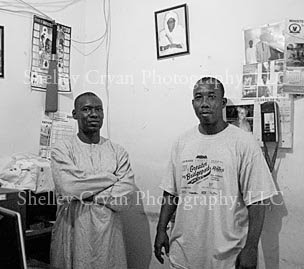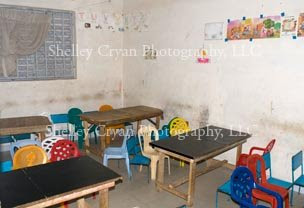
Shortly after we arrived at the school in a poor area of Dakar, Senegal, we met the school director, Diouma (on the right) as well as Masse (on the left). Masse is the director of the Waranka Association, which exists to help improve living conditions in the community (this area of Dakar is called Guinaw Rail). The Waranka Association oversees the school, as well as many other civic projects and services.
To understand how our group-- the Ludlowe Corps -- can best help the community of Guinaw Rail, I first needed to understand this wonderful Waranka Association. Masse told me the Association got its name from a hard-working, civic-minded woman who had done much to help the people of Guinaw Rail. Waranka Ba's photo hangs above the two men in the image above. She had fought to improve living conditions in this area that seemed to have been overlooked. She helped bring electricity, running water, and sanitation to the community. When she died in 2003, the community wanted to continue her work, and formalized it by creating an association named for her.
These days, Masse oversees this group, which focuses on education, health, and the environment. With constant threats of flooding, malaria, diabetes, illiteracy, and other troubles, it's a big job.
Masse inspires me. He works all day -- he is a professional librarian with a college degree from Dakar -- then spends much of his free time after work in the school, the clinic, or working on other civic matters. I would have liked to have met his wife and four children. I asked him how he is able to get so much done, and he just smiled graciously. He seems driven by a need to do what it takes to help his community.
I felt honored that this group would accept our Ludlowe Corps as a partner. Sure, we had all put forth efforts to raise funds for the school, but it pales in comparison to the work Masse, Diouma, and the others we met that day do every day.
Here is the website for the Waranka Association, including pictures from the Ludlowe Corps' visit in early April 2008.











